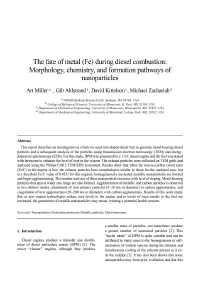 |
This report describes an investigation in which we used iron-doped diesel fuel to generate metal-bearing diesel particles and a subsequent analysis of the particles using transmission electron microscopy (TEM) and energy-dispersive spectroscopy (EDS). For this study, DPM was generated by a 1.5-L diesel engine and the fuel was doped with ferrocene to enhance the level of iron in the system. The exhaust particles were collected on TEM grids and analyzed using the Philips CM12 TEM/EDS instrument. Results show that when the iron-to-carbon (soot) ratio (Fe/C) in the engine is low, the exhaust particles have morphologies similar to those for the undoped case, but at a threshold Fe/C value of 0.013 (for this engine), homogeneously nucleated metallic nanoparticles are formed and begin agglomerating. The number and size of these nanoparticles increase with level of doping. Metal-bearing particles that span a wider size range are also formed. Agglomeration of metallic and carbon particles is observed in two distinct modes: attachment of iron primary particles (5-10 nm in diameter) to carbon agglomerates, and coagulation of iron agglomerates (20-200 nm in diameter) with carbon agglomerates. Results of this work imply that as new engine technologies reduce soot levels in the engine and/or levels of trace metals in the fuel are increased, the generation of metallic nanoparticles may ensue, creating a potential health concern
| Author(s): | Miller-AL, Ahlstrand-GG, Kittelson-DB, Zachariah-MR |
| Reference: | Combust Flame 2007 Apr; 149(1-2):129-143 |
tfomf (PDF, 1531 KB)